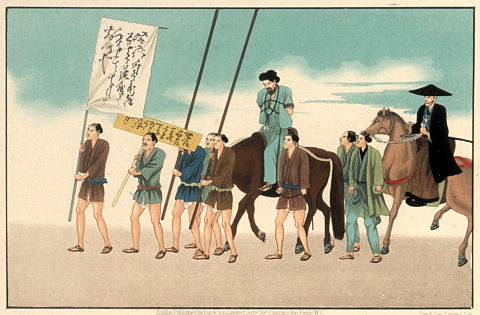Thrashemono
From Sketches of Japanese Manners and Customs, by J.M.W. Silver ("Lieutenant Royal Marines, Light Infantry; Late of the Royal Marine Battalion for Service in Japan"), "Illustrated by Native Drawings, Reproduced in Fac-simile by Means of Chromo-Lithography" (London: Day and Son, 1867):
Crimes against property are rare in Japan, which is owing to the high-spirited and honourable feelings that actuate all classes of the community; but from the feudal nature of the government, the small value attached to life, and the deadly weapons constantly carried, by the military classes, who are notoriously proud and revengeful, crimes against the person are very frequent.
A great check upon criminal offences is the severity of the punishments inflicted, and the disgrace entailed upon the culprit's family.
Although the laws are extremely severe, and in their administration there is neither jury nor counsel, justice is delivered with great impartiality; and the judge, who is generally the governor of the town or district in which the offence has been committed, is entrusted with considerable discretionary power.
When a prisoner is being examined his arms are bound to his sides by a rope, which also passes round his neck, the end of which is held by an official, who, if his charge prove unruly, manages him by pulls and jerks.
'Thrashemono,' or 'public exposure,' is associated with all Japanese punishments, and is said to be in itself a great preventive of crime, as the spirited Japanese dread being held up to the reprobation of their acquaintance more than they fear the extreme penalty of the law.
Thrashemono! Now there's a word I wish had made it into English. Maybe someone can persuade John Zorn to use it in an upcoming project.
Silver is speaking, of course, of sarashimono 晒者, made of sarasu (to expose, e.g. to the elements) + mono (person, thing). The word sarashimono refers to the person so exposed, rather than the act, as far as I know. Silver also includes an illustration of this punishment being applied to a man who appears to be Jesus:

The illustration, showing the mode of conducting a criminal to execution, is an instance of 'thrashemono.' The culprit is bound on a horse, and is preceded by a placard, borne by his relatives or neighbours, and indicating his crime. In this manner he is conducted through the town to the place of execution, where his sentence is read to him. He is then placed (with his limbs still bound) over a freshly-dug hole, where he is supported by his relatives till the executioner's sword performs its task.
After execution, the heads of malefactors are generally exposed: that of Simono Sedgi [Shimizu Seiji, more commonly pronounced Shimizu Kiyotsugu 清水清次] (the lonin [sic!] who was decapitated in the presence of the British garrison of Yokohama, for being the organizer of the assassination of Major Baldwin and Lieutenant Bird of Her Majesty's 20th Regiment) was exhibited on the public stand at the guard-house at the entrance of the town.
This man was a fair specimen of the lonin type, and was a most determined ruffian, whose whole life had been a career of crime.
When exposed in the streets of Yokohama the day preceding his execution, he conducted himself with great bravado, remarking on the improvements in the town since he last visited it, and expressing his regret that he had not killed a consul...
There would be a national holiday in this guy's honor if he'd been Australian.
![[No-sword]](http://no-sword.jp/images/site/no-sword_banner.jpg)



Avery:
A Japanese politician got in trouble a few years back for urging the Justice Department to bring back sarashimono. Amusing enough that I translated it, here:
http://en.wikipedia.org/wiki/Yoshitada_Konoike
(The modern Japanese word for it seems to be 市中引き回し. I do like "thrashemono", though.)